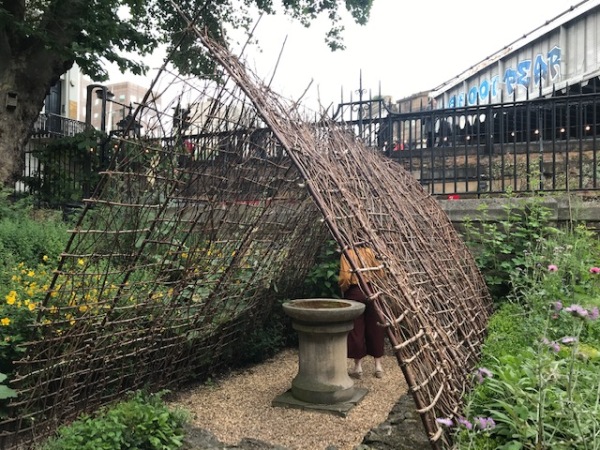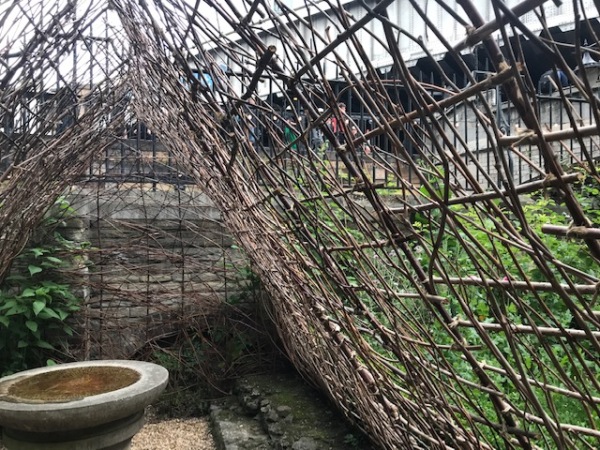When I was a young lad my sister and I always used to look forward to Thursday. Life does often seem to go full circle and before ever there were on-line deliveries and looking out for the Tesco van arriving or whoever you use, there used to be grocery delivery boys. I would be asked by my mum to slip the grocery order book under the door of our local Co-op on the way to school. Then at tea time a boy would arrive with a big box, somehow balancing on the front of his bike, containing the things that mum had ordered and the next day she would call into the shop and pay what she owed and get her ‘divi’. What we loved was the box that the groceries arrived in. We would play with that box for hours – make it into a boat, make it into a car, and if it was big enough, make it into a house.
Children often create ‘dens’, at the back of the garden, on a piece of waste ground, even under a table at home. That I suppose was what was so appealing about that lovely book we read as children ‘Stig of the Dump’ by Clive King. Barney enters the dump to find an old dilapidated hut and in it, a caveman. But whether in the dump or the back garden we have the instinct for creating a space in which to dwell, with a box, or with twigs.
We have worked with the artist Angela Wright at Southwark Cathedral on four occasions. Angela is an artist weaver and has used wool in the past for her installations. Wool has hung from the great screen, woven its way around the restored bells as they waited to blessed and reinstalled in the tower, hung along the Link for ‘Wool Week’. But in her latest piece of work for us she has left wool behind and chosen branches and twigs as the material with which she would work. As part of the London Festival of Architecture she has created ‘The Garden Cocoon’ in the Herb Garden, which is the eastern most part of the church yard which stands closest to London Bridge.

‘The Garden Cocoon’ by Angela Wright
It’s a beautiful bit of garden. You can see the remains of the medieval chapel that once stood there, demolished to make way for Rennie’s London Bridge and now filled with herbs to remind us of the founding of St Thomas’ Hospital there by the Augustinian Friars of the Priory of St Mary Overie. There are birds and urban foxes and the hum of the traffic and the rumble of the trains but also a strange and unexpected peacefulness among the plants. Into that space Angela has built this structure.
She took hazel and has woven it, beautifully, but also allowed each branch, each twig to find its own place in the structure. She was telling me that it is amazing working with that material and allowing each piece to find its natural partner and to click into place. The result is a gentle arched space, a room, an almost Gothic room reflecting the architecture that stands close to it, into which you are invited to enter.
There are wonderful detailed sections in the Book of Exodus about how the Tabernacle was to be constructed. Looking at the ‘Cocoon’ in the Herb Garden reminded me so much of what we read in Exodus 26
You shall make upright frames of acacia wood for the tabernacle. Ten cubits shall be the length of a frame, and a cubit and a half the width of each frame. There shall be two pegs in each frame to fit the frames together; you shall make these for all the frames of the tabernacle. (Exodus 26.15-17)

Beautiful and simple
And the instructions are there for every element as the people created a dwelling for the divine in their midst, a place that God could call home. Later, for the building of the Temple there would be more instructions. But they were for a permanent house. Instead this first Tabernacle was to be put up and taken down, it would travel with them as they travelled, the Lord would camp with them as they camped and this would be the divine ‘den’.
Yet can we really build a place for God to inhabit? Some birds build elaborate and beautiful nests in the hope that they can attract a mate with their sumptuous bower and their love never appears. This is something of what R S Thomas means in his poem ‘The Empty Church’.
They laid this stone trap
for him, enticing him with candles,
as though he would come like some huge moth
out of the darkness to beat there.
Ah, he had burned himself
before in the human flame
and escaped, leaving the reason
torn. He will not come any more
to our lure. Why, then, do I kneel still
striking my prayers on a stone
heart? Is it in hope one
of them will ignite yet and throw
on its illuminated walls the shadow
of someone greater than I can understand?
We can build something really beautiful but we cannot guarantee that it will be holy, the inhabited place, the tabernacle of God. In 1 Samuel a boy is given a strange name
She named the child Ichabod, meaning, ‘The glory has departed from Israel’. (1 Samuel 4.21)
And then I notice in a street on my way to the Cathedral that someone has taken a box and is living in it. A person, living on the street for a reason, I do not know why, has taken a box as I did when I was a little boy and made it into a den, a home, a shelter, a cocoon. And because I know that ‘the Word became flesh and lived among us’ (John 1.14) I know that this might be the strange tabernacle in which God chooses to dwell, now.
Loving God,
dwell among us,
tabernacle alongside us,
cocoon with us,
that we might be at home with you.
Amen.

You must be logged in to post a comment.